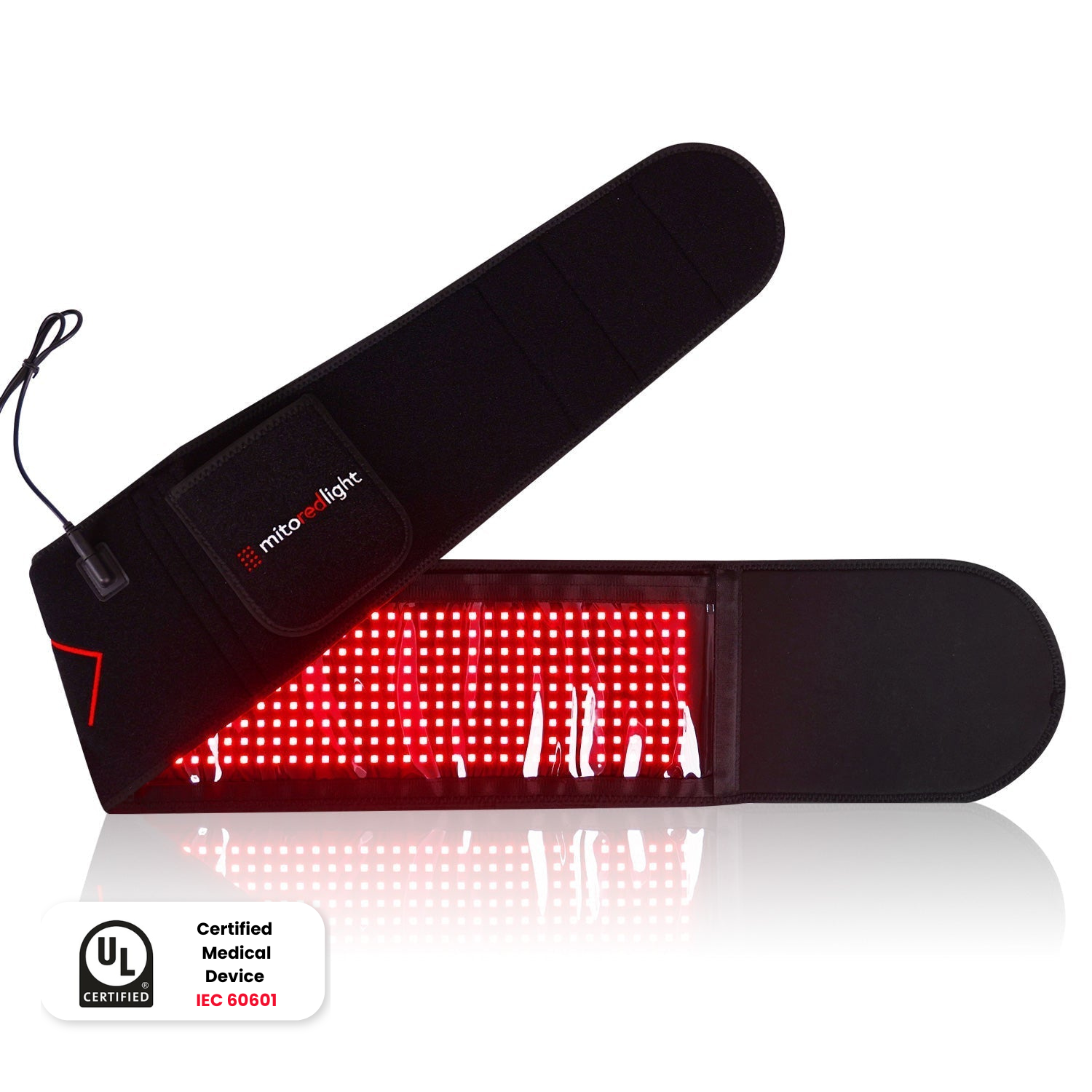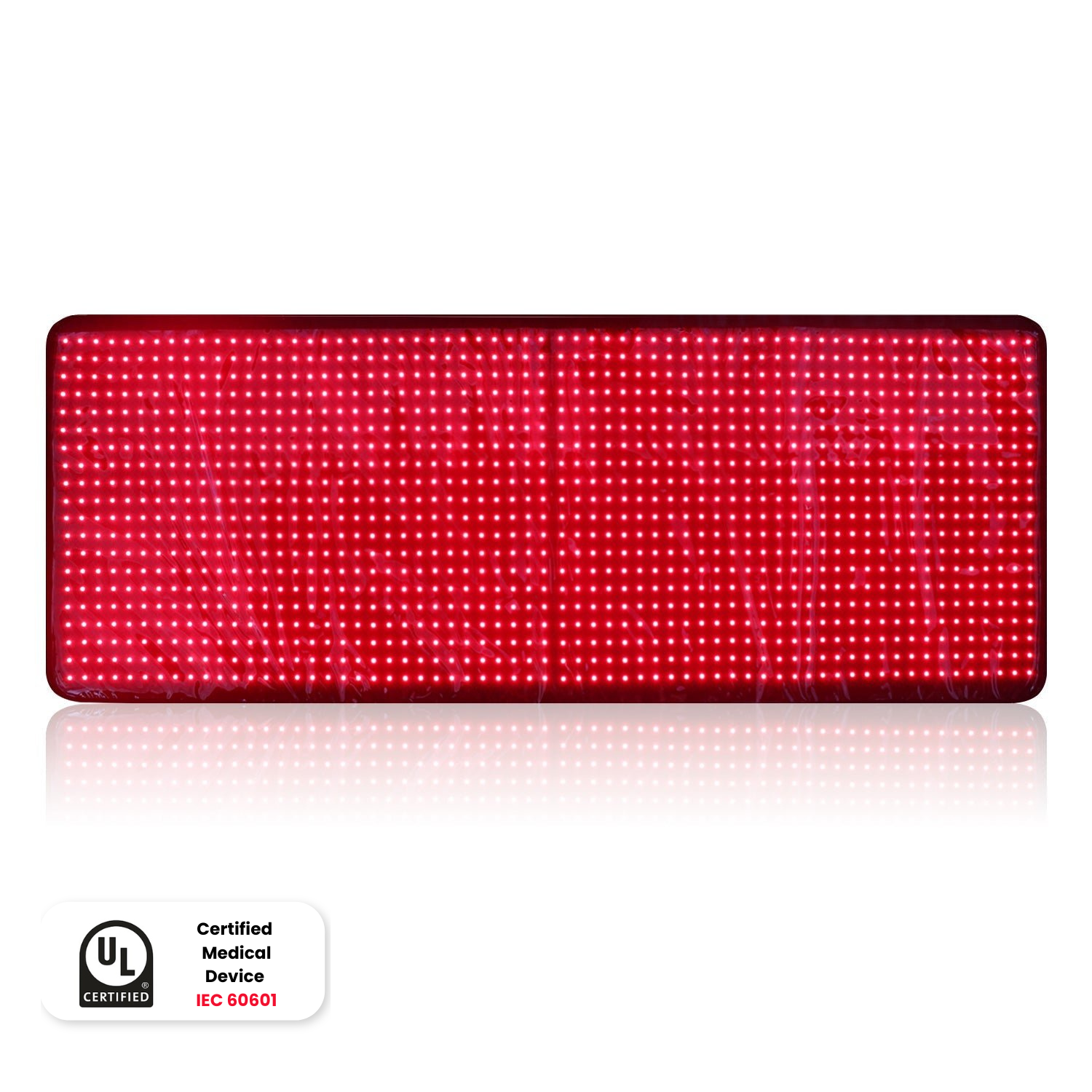DISCLAIMER: Mito Red Light devices are Class II wellness devices aimed at affecting the body through topical heating and supporting cellular function. The information provided in this article and on this site is for educational purposes only and is not intended to imply effectiveness of Mito Red Light devices for any specific application. The information provided in this article and on this site is not intended to diagnose, treat, cure, or prevent any disease, is not a substitute for consultation with a licensed medical provider and should not be construed as medical advice. Click here to read our article on potential contraindications of red light therapy..
Table of Contents
- Starting to Use Red Light Therapy
- Principles of Red Light Therapy
- Time
- Distance
- Exposure
- Safety Considerations
- Track Your Progress
Red light therapy is a new, promising form of therapy that has grown in recent popularity. Red light therapy benefits are realized by using specific wavelengths of light in the red and near-infrared (NIR) range to irradiate body tissues. Researchers believe that wavelengths of light within the ranges of red and NIR light stimulate mitochondria, the tiny intracellular organs responsible for producing energy within the cells and suppressing inflammation.

While the benefits of red light therapy have only been more recently understood, beginning with research sponsored by NASA in the 1990s, there are now several major reasons that people around the world use red light therapy on a consistent basis. Some of these reasons include:
- Skin Health - Research suggests that red light therapy improves skin quality and health by creating an even skin tone and by improving skin elasticity and skin tone.
- Inflammation - Current research shows that red light therapy acts on mitochondria, an important factor for controlling inflammation. Studies show that red light therapy improves inflammation and the pain that it causes.
- Joint and Muscle Pain - Many people find red light therapy helpful for joint and muscle pain, whether this pain is caused by a medical condition or is exercise related. Studies show that red light therapy may reduce muscle fatigue and speed recovery after a workout.
- Immune Health - While red light therapy does not stimulate vitamin D production, research suggests that it does increase the efficacy of ultraviolet light in producing vitamin D. Vitamin D plays an important role in immune health, making this function of red light therapy an important one. You can read more about this in our article: "Red Light Therapy and Vitamin D?"
- Sleep Quality - While the research into red light therapy for sleep is less than a decade old, there are early studies that suggest it may improve the quality of sleep and make sleep more rejuvenating. For a full discussion on RLT and sleep, as well as some helpful tips, read our article: "Red Light Therapy and Quick Tips to Getting Better Sleep."
Research into the benefits of red light therapy is still ongoing, and new discoveries are continually being made.
Starting to Use Red Light Therapy
If you are new to using red light therapy, it is very important that you understand how to use it. The benefits that red light therapy are used for occur slowly, and it may take a few weeks to realize that you are not seeing the results that you expected. By understanding how to use red light therapy from the beginning, you will be best positioned to see benefits sooner.
Principles of Red Light Therapy
Red light therapy technically uses electromagnetic radiation (the scientific name for light or radio waves) that is applied to the external body tissues. There are many types of electromagnetic radiation or other types of radiation that are used in medical treatments.
Some forms of radiation used for medical purposes can be potentially harmful. The radiation used in X-rays or cancer treatments, for example, can cause cancer when someone is exposed to high amounts of this radiation or exposed to small amounts over time.
Red light therapy, however, is thought to be essentially harmless, even in large amounts. While other forms of light, like ultraviolet light, may cause skin cancer with prolonged exposure, red light has not been found to have these harmful effects, even in high, intense amounts.
There are basic radiation safety principles that are used to protect medical workers and patients from harmful types of radiation. The three main principles of radiation safety with harmful radiation types include:
- Time - With harmful radiation, the longer someone is exposed to it, whether in a single episode or multiple small episodes, the more the effects of the radiation will build up.
- Distance - Radiation spreads as it emits from its source. This means that the closer someone is to the source of radiation, the more intensely it will affect them.
- Exposure (or shielding) - Any radiation can be at least partially blocked by any type of matter. Shielding could range from lead shielding to protect healthcare workers from the radiation used in cancer treatments to the sunscreen you use to protect yourself at the beach.
With harmful radiation types, limiting time, distance, and exposure is important. With red light therapy, a safe form of therapy, these factors are important from the opposite perspective. Because the goal of red light therapy is to affect the cells as much as possible, you will want to maximize all three of these components to have optimal exposure to the red light sources that you are using.
Time
By optimizing the time that you spend doing red light therapy, you will be able to get the most out of it. The time component of red light therapy has two aspects. One is the frequency with which you do red light therapy, and the other is how long each therapy session is.
The key to the frequency with which you do red light therapy is consistency. Ideally, you should aim to use red light therapy 3-5 times each week. To ensure that you are consistent with your red light therapy sessions, you may find it beneficial to use your red light panels at a certain time of day.
The time of day that you consistently use your red light will depend in part on why you use it. If you use red light to promote sleep, it would be ideal to use the therapy in the evening. If your goal is to promote workout recovery, therapy should be used after you work out. Other goals, such as improving skin quality, may not be tied to a certain time of day and should be done whenever is most convenient.
The duration of each session is another time-related consideration. The optimal timing for this will be different for everyone, and longer may not necessarily be better. The effect that red light therapy has on the mitochondria may diminish with prolonged exposure, and Mito Red Light recommends sessions that are between 5 and 15 minutes.
Distance
The closer you are to the red light source, the more intense its effects will be. There are, however, a couple of considerations that make it unwise to apply the light source directly to your skin. One consideration is that the source of red light typically creates some amount of heat. While this heat is usually almost imperceptible, as you get closer to the source, it may have more of an effect. There may be a risk of discomfort or even burns if your skin is too close to the source.
The other reason that you should keep some distance between yourself and the red light source is that as the light travels, it spreads. If your skin is right against the red light source, the therapy will affect a smaller area of your skin or tissues. Positioning yourself even a few inches away from the red light source can improve the coverage of the therapy. Mito Red Light recommends that you position yourself about 6 to 12 inches from our red light panels to achieve the best distance balance possible.
Exposure
To ensure the optimal activity of red light therapy, you should have nothing between your skin and the red light source. While the most obvious potential barrier is clothing, you should also consider that sunscreen, lotion, or makeup can all be potential barriers that could affect how effective red light therapy will be.
In addition to reducing barriers to the red light, exposure also should take into consideration the source of the light. The more intense the light is and the more surface area that the light source creates, the more exposure you will achieve. Larger devices will create more exposure than smaller devices, and more powerful devices will increase the exposure that is experienced.
Safety Considerations
Red light therapy is considered to be quite safe, as it is external, associated with almost no potential complications, and uses the least damaging wavelengths of light. While red light therapy carries almost no risks, there are some safety considerations that are generally recommended.
Some of the key safety considerations for red light therapy include:
- Discuss it with your provider - Ultimately, you should always talk with your doctor about if red light therapy is safe for you and your situation. No one article can discuss every single situation, and your doctor is positioned to understand your unique circumstances and if red light therapy will be safe for your specific situation.
- Avoid if pregnant or breastfeeding - Red light therapy has not been specifically tested with those who are pregnant or breastfeeding. While there are no known risks, it has not been proven to be safe, and you should consider avoiding red light therapy if you are pregnant or breastfeeding.
- Do not use if recovering from Lasik surgery - While red light therapy is not thought to be harmful for eye health, research in this area is still ongoing. Those recovering from Lasik surgery are particularly susceptible to eye damage, and red light therapy is not recommended while recovering from Lasik surgery.
- Use protective eyewear - The American Academy of Ophthalmology (AAO) reports that "a study in The Journals of Gerontology found that brief exposure to deep red light improved older adults’ [eyesight].” Researches into the eye effects of red light therapy are still, however, being researched, and using protective eyewear is still recommended. For a full discussion on RLT and the eyes, read our article: "Red Light Therapy and The Eyes – What does the Science Say?"
Track Your Progress
Red light therapy works slowly over time. Tracking your progress will enable you to see how red light therapy has helped you over time. The way that your track your progress will vary based on what you are using red light therapy for. Measuring your progress may include taking weekly photographs of your skin, measuring your workout performance over time, or even keeping a sleep or pain diary.
Mito Red Light
Not all red light therapy panels are created equal. For red light therapy to be worth the investment, you need a high-quality, independently tested, professional red light therapy device from a reputable company. With over 5 years in business and over 65,000 ecstatic customers, Mito Red Light is a brand you can trust. Our reviews speak for themselves and you can also click to review some of our customers' red light therapy before and after examples.
We are confident that our devices are the highest quality and best value you’ll be able to find anywhere. We welcome you to review our selection of red light therapy devices or to contact one of our representatives at 1-866-861-6486 to learn more or to help find the right solution for you.































